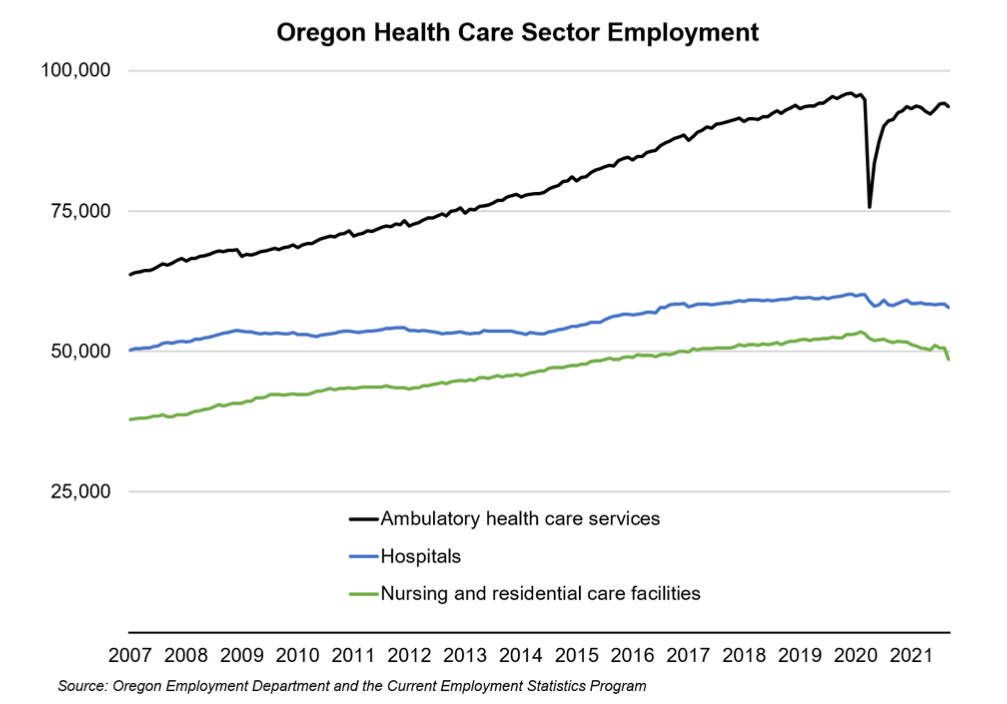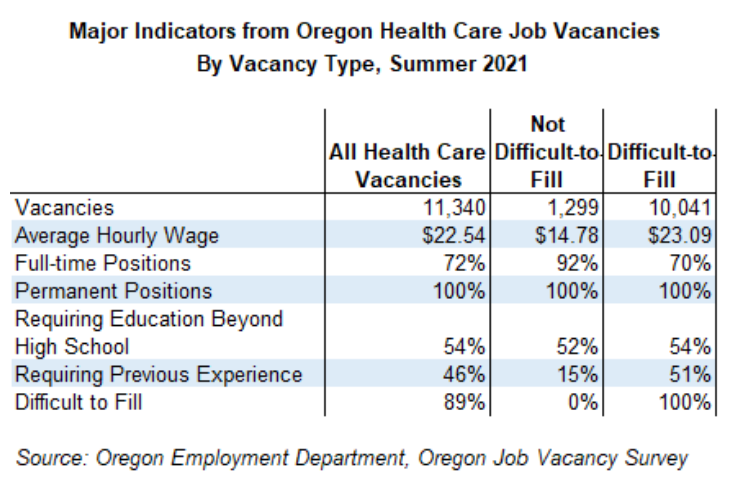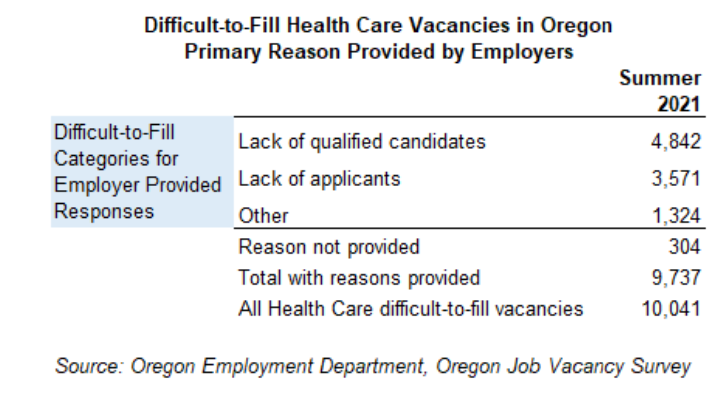Health Care Job Vacancies in Summer 2021
By Anna Johnson Senior Economic Analyst, Oregon Employment Department anna.l.johnson@employ.oregon.gov

Each quarter, the Oregon Employment Department surveys private employers from all industries and areas of the state to ask about the job vacancies they are actively trying to fill. Oregon businesses reported 107,000 vacancies in summer 2021, a record high.
For this analysis, health care vacancies are narrowed from the broad “health care and social assistance” industry that is typically used. This broad industry reported 20,900 vacancies in the summer of 2021. “Health care” job vacancies in the context of this analysis refers to a vacancy that falls within the health care and social assistance industry and the occupational groups of healthcare practitioners and technical occupations or healthcare support occupations. Using this designation, there were about 11,300 job vacancies in health care in summer 2021, and 89% (10,000) of these vacancies were considered difficult to fill by employers.
The health care difficult-to-fill job vacancies had a higher average wage and were more likely to require previous experience than the not difficult-to-fill health care job vacancies. Difficult-to-fill health care positions were less likely to be full-time positions, at 70% full time. Difficult-to-fill and not-difficult-to-fill vacancies were almost equally as likely to require education beyond high school and to be permanent positions.
For each difficult-to-fill vacancy, employers are asked for open-ended responses about their primary challenge filling the opening. Responses are then categorized into 12 common reasons for difficulty. In summer 2021, a lack of applicants and lack of qualified candidates represented a majority of the primary reason employers cited for difficulty filling vacancies. All other cited reasons, including low wages, lack of training, and unfavorable working conditions, represented only 13% of difficult-to-fill vacancies. Within the difficult-to-fill health care vacancies, the occupations with the most difficult-to-fill vacancies were personal care aides, dental assistants, and nursing assistants. Together these occupations represented 62% of the difficult-to-fill health care vacancies.
In summer 2021, 15% of all difficult-to-fill vacancies mentioned either COVID-19 or unemployment insurance benefits as a reason for the vacancy being difficult to fill. In health care, only 3% of the difficult-to-fill vacancies mentioned COVID-19 or unemployment insurance benefits.

Many employers referred to a “shortage” of health care workers as the difficult-to-fill reason. A shortage of workers was a common refrain in the pre-2020 expansion period and is not unique to the pandemic era. The most unique part of the difficult-to-fill responses is the sheer volume of them. Many employers are hiring for similar positions at the same time, while also dealing with a dangerous pandemic. Health care jobs in particular are on the frontlines of fighting the effects of the pandemic and may be dealing with a lot of burnout among current staff as well as difficulty attracting new workers.
What is unique to the pandemic era is the record number of quits in the health care industry. Across the U.S., the number of people quitting jobs in the health care industry surged in July and August 2021, to more than 600,000 per month, from an average of 407,000 per month in 2019. The national quits rate in health care reached 3% in July and August, the highest rates on record dating back to 2011. These figures come from the Job Openings and Labor Turnover Survey (JOLTS).
The health care industry has made significant progress recovering jobs lost in the early months of the pandemic. Early job losses in health care were concentrated in ambulatory health services, due to cancellation of nonessential procedures and appointments and closure of many medical and dental clinics in the short-term as they worked to update processes for pandemic safety.
While those early losses hit ambulatory services hardest, those jobs returned fairly quickly over the remaining months of 2020, while employment in hospitals continued to drift sideways and nursing and residential care facilities continued to lose jobs. As of September 2021, employment in hospitals was 3.8% below its level in February 2020, just prior to the onset of the pandemic. Ambulatory health care services employed 4.1% fewer jobs than prior to the pandemic, and nursing and residential care facilities had 5.1% fewer jobs.

As the pandemic continues, Oregon’s health care employers are facing many hurdles to filling jobs. Many of the positions that are open require previous experience and education beyond high school. As employers report record levels of hiring across industries, health care is competing with opportunities across sectors. The training and experience required to meet the needs of the health care industry can take time to translate to a ready workforce.
Outside of the short-term hiring constraints, health care in Oregon provides great opportunities to workers who get the right training and experience. Many of the state’s high-demand and high-wage jobs are found in the health care industry, and that’s a trend that is expected to continue as the population continues to grow and age. Choosing a career in health care now will lead to continued opportunities in the future.
Employers in all industries and areas across Oregon are reporting difficulty filling the record numbers of job vacancies. Learn more about what employers have said about their difficult-to-fill vacancies in responses to the job vacancy survey here.


Advertisement